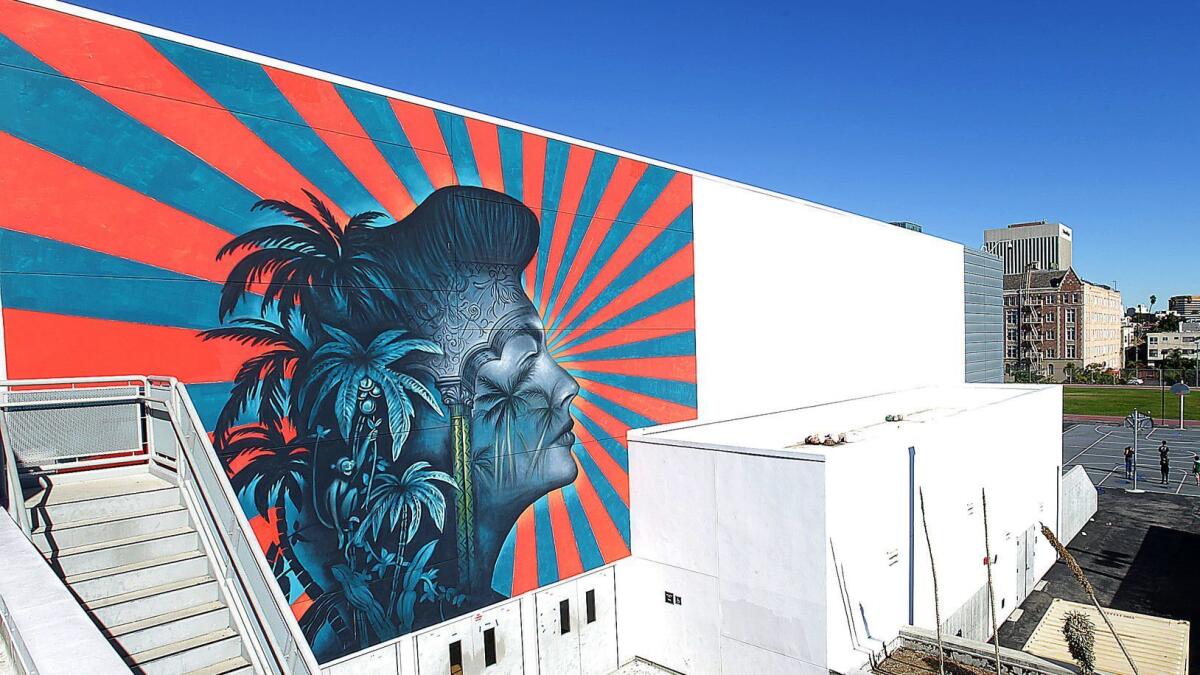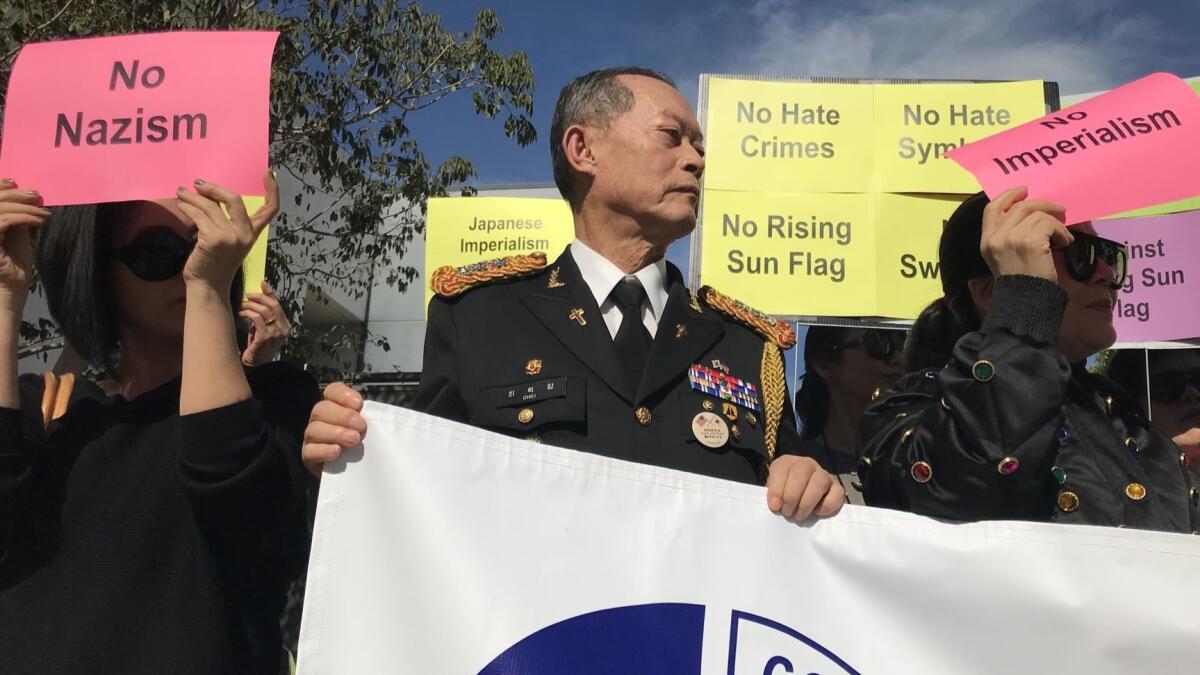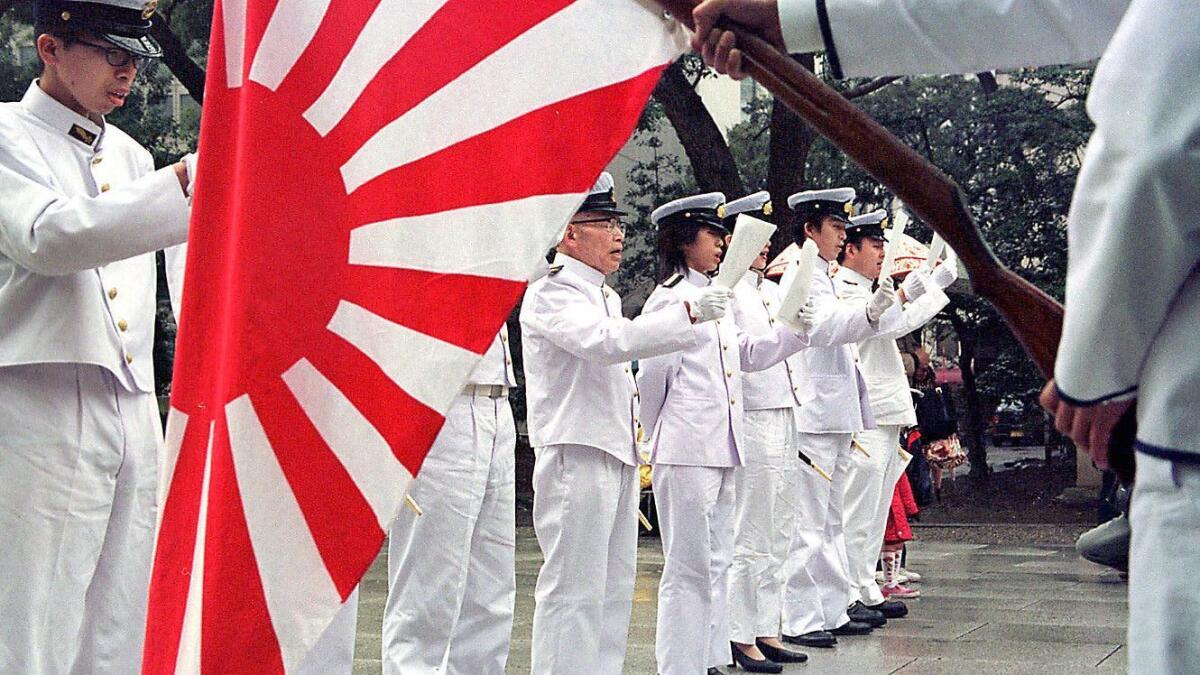A mural at a Koreatown school pays homage to classic Hollywood. Some say it’s as offensive as a swastika

- Share via
The giant image of Ava Gardner on the outer wall of a public school gym in Koreatown speaks to history. On that score, everyone agrees.
But what the artist intended as an homage to the Cocoanut Grove, which once stood nearby, Korean groups say is as offensive to them as a swastika would be to Jews or a burning cross to African Americans.
They don’t object to the movie star, who frequented the famed nightclub, or to the palm trees, monkey and Moorish arch superimposed on her profile to evoke the club’s exotic decor. At issue are the rays radiating out from her face, which they say look like those on the rising sun of the imperial Japanese battle flag used during World War II — when Japanese forces committed atrocities against Koreans and others.
The protests of the Wilshire Community Coalition — with its long list of local groups and scholars — have prompted the Los Angeles Unified School District to take assertive action. The district has agreed to paint over the mural at the Robert F. Kennedy Community Schools complex during winter break, said Roberto Martinez, the senior school district administrator for that region.
The artist who painted the mural is stunned. So is the National Coalition Against Censorship, which represents a variety of groups including the American Assn. of School Administrators and the American Civil Liberties Union.
“Removing the mural … sets a dangerous precedent of submission to public pressure in assessing art and allowing students’ access to diverse viewpoints and ideas,” the coalition said in a statement.
Martinez estimated that removing and replacing the mural would cost about $20,000.
“Art is intended to celebrate the human spirit, not to offend the community,” Martinez said during a news conference in the school library last week. “If we have offended anybody, I apologize.”
To Chan Yong “Jake” Jeong, who led the mural protest and celebrated at Thursday’s event, the district’s announcement represented “such a happy day.”
But Beau Stanton, who had donated his time to paint the mural, was taken by surprise.
“I’m really disappointed,” said Stanton, who was in Miami on business when the district made its decision public. “My understanding was that this event was going to be a conversation. I had heard that teachers from the school were going to be speaking on my behalf. I was hoping we could have this opportunity to speak to the community and assuage some of these concerns.”

Those who objected to the rays on the 30-by-40-foot image say they are too reminiscent of the controversial flag.
“This flag symbolizes the Japanese military aggression which resulted in [some] of the most horrendous and gruesome crimes against humanity in human history,” the Wilshire Community Coalition wrote in a Nov. 15 letter to the school system.
“We love Japan and Germany!” they wrote. “However, such cruel history against humanity is not to be repeated.”
Early in the Meiji era, which began in 1868, the military adopted the sun-ray flag, said UCLA associate professor William Marotti, a specialist in modern Japanese history. That flag became strongly associated in historical memory with the events leading up to and including World War II.
The atrocities of the Japanese regime — recounted by the Korean groups — include the use of chemical weapons, brutal forced labor, the subjugation of women from Korea and other conquered lands as sex slaves and the grotesque medical experimentation of the military’s notorious Unit 731.
Many Koreans remain bitter over Japan’s rule of their homeland as a colony from 1910 to 1945.
An exacerbating factor for those who object to the flag may be that some supporters of Japanese Prime Minister Shinzō Abe have downplayed or even denied the Japanese government’s active involvement in the deceptive “recruitment” of the sex slaves, known as comfort women, during the war, said Katsuya Hirano, a UCLA associate professor who specializes in the history of Japan.
“It is unfortunate that an innocent artwork has to be involved in the politics of war, memory and redress,” Hirano said.
Those who attended the news conference Thursday included Young Park, who spoke about how his grandfather, Dr. Kwan Joon Park, was imprisoned after leading a 1939 protest in the Japanese Diet, or parliament. The elder Park died in prison in 1945, shortly before Korea’s liberation from Japan.
Many critics do not feel as though Japan has taken full responsibility for past wrongdoing. Nor has it fully renounced symbols that others associate with these crimes — the battle flag being the prime example.
The issue is partly generational, partly geographical, said Jennifer Jung-Kim, a UCLA history lecturer who is Korean American and grew up mostly in the U.S. To her and her U.S.-raised son, the resemblance to the flag is remote, “but my husband lived in Korea until he was 14. He sees it very differently. To him the mural looks very reminiscent of the rising-sun flag.”
Some Japanese have defended the sun-ray image, which they say dates back long before the creation of Imperial Japan. The Japanese Navy and civil defense force still use versions of it in their flags. The motif has been woven into the leotards of Japanese Olympic gymnasts.

Such discussions have nothing to do with his mural, said Stanton, a 32-year-old artist who splits his time between Los Angeles and New York.
The history he pulled from was that of the Cocoanut Grove, for decades one of Hollywood’s top watering holes. Big names both relaxed and performed there. It repeatedly hosted the Academy Awards. The Grove was attached to the equally historic Ambassador Hotel, where Kennedy was assassinated in 1968.
The sun rays on the mural also differ in appearance from those on the flag.
The Japanese battle flag has 32 red-and-white bands, of uniform proportions, emanating from a central red sun. Stanton’s mural has 42 bands of varying sizes in blue and reddish orange, surrounding a much larger and strikingly different central image.
“Radial lines terminating at a focal point are a common design choice” going back to ancient China, Stanton said. The motif appears in many places, including the flag of Arizona, he said, then added, “I think I just threw Arizona under the bus.”
His school mural was part of a 2016 project to place murals across the campus. Local activists began raising objections this fall, said Sharon Joung, a spokeswoman for the coalition.
The artist’s good intentions are not the issue, local superintendent Martinez said: “As beautiful as they might be, Confederate statues have memories and mean a lot of different things to different people. It’s the same thing here because for many older generations of Koreans, this mural might evoke memories of the past.”
Jeong, of the coalition protesting the mural, said the artwork could even be likened to a hate crime. He said his group had been prepared, if necessary, to take legal action against the nation’s second-largest school system.
Under law, an act is only a hate crime if it embodies an attempt to terrorize or intimidate another, said John F. Banzhaf III, a lawyer with experience in hate-crime cases and a professor of public interest law at George Washington University.
Sun rays are a common motif in Stanton’s murals. He now worries that activists will object to others.
The artist’s defenders include Janette Tovar, a retired administrator who is working part time coaching teachers on the RFK campus. She said the district should have stood on the side of artistic integrity and opposing censorship.
“This mural was designed to be an icon for the historical significance of the building,” Tovar said. “Who is to say that the new mural they put up is not going to offend someone else?”
Twitter: @howardblume
More to Read
Sign up for Essential California
The most important California stories and recommendations in your inbox every morning.
You may occasionally receive promotional content from the Los Angeles Times.











